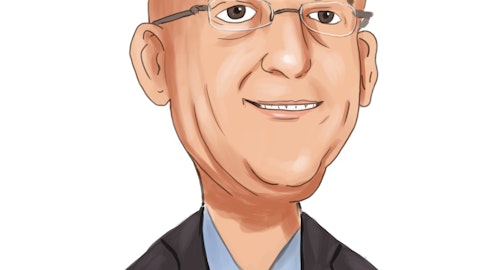Colin Rusch: On the partnership pipeline, can you talk about just the order of magnitude of the number of partners that you guys are engaged with and kind of how mature those conversations are at this point?
Dave McMurtry: This is Dave. We’re very excited about our coming year because the pipeline is very full. And they €“ again, I can’t share names, we’re under NDA, but they are the largest, both offtake and feedstock providers, meaning those who are making black mass €“ we’re talking to the biggest three, those who are taking black mass and turning it into batteries or other products are also the largest in the categories. And they’re very mature. So we’re very excited about the coming year.
Operator: I’ll now hand it over to Bob Meyers to continue.
Bob Meyers: We certainly have some questions coming in on the portal. And I’ll jump right in. So, first, this is in the grants and government relationships area. Can you offer additional details about your efforts with the DoE and the grant status and how those efforts are going kind of overall and in general?
Dave McMurtry: This is Dave again. So, I recognize I hit the government category a little quickly. It might be worthwhile to spend another minute explaining the process. So for those who haven’t been watching the DoE or understand the IRA and how it’s different from the BIL, the bipartisan infrastructure law, it’s the latter, the BIL, that has set aside $6 billion for this space. $3 billion Department of Energy, the DOE. The first $3 billion €“ first round went out this year. And it was in the first three categories of the DOE, which is extraction, processing, and component manufacturing. We expect the second round to be further downstream in cell pack manufacturing applications and recycling. For those who aren’t aware of the DoE process, it’s three steps €“ an RFI where they are requesting information, there is a concept paper where you write three to five pages on your solution to their problem, and then finally, if you receive a letter of application, which is a minority of the concept papers, you receive a letter of encouragement to a write full application.
We have received a letter of recommendation on our most recent grant, 2768, which means we are encouraged to continue based on our concept and technology is a solution to a problem the DoE thinks needs to be solved. So we are prepared now. We have a full team staffed, which includes our DC based advisors, to respond to multiple FOAs or funding opportunity announcements that come from the DoE. And we’ll have a lot more to say about this, as well as future FOAs very soon.
Bob Meyers: We touched upon this a little bit with some of the questions from the analysts. But there is a move toward some of these LFP batteries. And can we talk a little bit about how that affects us?
Steve Cotton: This is Ben. Fortunately, for us, because we’re able to recover the lithium, it doesn’t have near the effect on us. Lithium is one of the more valuable metals in the recycling stream that we’re able to recover in a hydroxide form. So, we’re currently recycling that today as part of our mix. And we expect that that will likely increase in the future and we’re prepared for that. And we think we can create a process flow that effectively processes that as part of our mix. Also should be noted that our first partner is actually an LFP manufacturer, Dragonfly. So, we’re working closely with them both on ontake and offtake.
Bob Meyers: A couple questions coming in about the campus facility. And maybe we could talk a little bit about that from a strategic standpoint, the location, our kind of vision of that campus, if you can.
Steve Cotton: This is Steve. So, the strategic value of the campus being nearby is very helpful for us because our engineers, scientists and commercial team are all based out of the Tahoe-Reno area. And so, that allows for our first plant incarnation on a commercial level to really be closer to home and for us to really be able to move as quickly as we can. Over time, as we talk to the partner network that Dave was talking about, there are partners that have opportunities with the deployment of our technologies at other locations. And we’re going to consider those, and we will probably have more to say about that in the longer run. But the real birthplace and the key anchor for us, it has been and always will be right here in Reno in Nevada, the lithium state.
Bob Meyers: Maybe this is related to that because there’s some questions about kind of longer term vision, we’ve outlined the campus and we have a couple of different business models with the different minerals. Can you maybe talk about how we see the lithium business playing out? And is this possible that leads into other business models in the future?
Steve Cotton: Our primary business model with the lithium AquaRefining is really to build and operate plants and enjoy all the profits associated with the creation of the various minerals that we create. But the partnership opportunities can also enhance our revenue opportunities and even affect our business model. Now, I’ll ask Dave to comment on different kinds of arrangements other than just solely owning and operating that we could potentially consider with some of these partners.
Dave McMurtry: This is Dave. And we’re talking now with many partners who have extended their businesses beyond NMC. Quite frankly, the categories of batteries, the chemistries we’re now talking about going high nickel, which is a nice way of saying low cobalt because of the geopolitical challenges of cobalt. If you’re unaware, 70% of the world’s cobalt comes from one province in the DRC, which is a politically challenging. People also in other categories like data centers and ESS are wondering about different types of chemistry. So the beauty of the Aqua Metals technology is that we are not NMC centric. We can use our technology, our clean and renewable technology to work on very different battery chemistries. So we are broadly able to serve many different sectors.
Bob Meyers: Another question here around the €“ as we anticipate minerals and materials, offtake partners, opportunity to sell these into the commodities market, are we able to talk about high level kind of revenue predictions.
Steve Cotton: From a revenue perspective, the good news this year for Aqua Metals that we will be probably the first company in the US and North America to enter revenues for the minerals that we produce from €“ that we derive from black masks. But because we’re at a pilot stage, it’s not going to be a gigantic amount of revenue in 2023. But that will start to change as we get around the corner into 2024 with phase one of our campus deployment. And I’ll ask Judd to comment on what his views are and the revenue model as he is the CFO.




